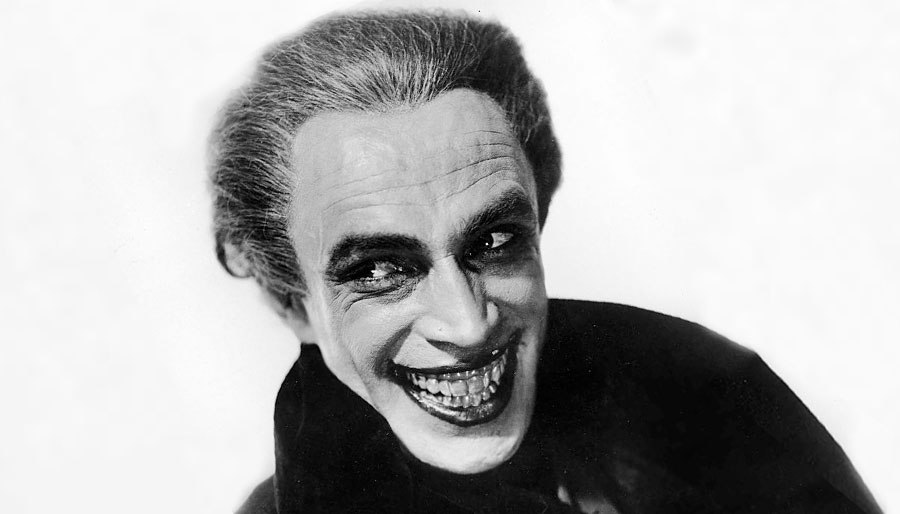
Conrad Veidt Resonates
Over the course of his relatively short life, German actor Conrad Veidt appeared in over 100 films. With 2020 marking the centennial anniversary of The Cabinet of Dr. Caligari, it prompted me to consider three distinctive Veidt performances, how each is uniquely different from the others, and how they all resonate to this day. Let’s start with the obvious…
The Cabinet of Dr. Caligari (1920)
Cesare the Somnambulist is a combination of nuanced tics and grandiose theatrical gestures – observe the close-up of his black-ringed eyes slowly blinking to life at Caligari’s (Werner Krauss) command during his initial appearance at the local fair. Contrast that against the cartoonish tongue-waggling as he abducts the female love interest.
As a character, Cesare is a conundrum: a psychosocial anomaly, a romantic (watch how he serenely caresses a flower in the film’s final moments), and a programmed killer. Little wonder that his black-clad visage became the uniform of choice for disaffected folks who never felt a sense of belonging.
To a certain degree, youthful rebellion manifests in a sense of feeling like one has no control over the course their lives will take. In this way, Cesare – and Veidt’s depiction of complicity – becomes a reflection of the adverse effects of control-based systems like religion, politics, and patriarchy. He’s stuck in a literal limbo of having his free will stolen by a predatory sorcerer.
There’s a moment near the end in which Caligari has an outburst in front of the police and his psychiatric contemporaries. During this frantic scene, Cesare, “decommissioned” from his sleepwalking state, lies closed-eyed on a stretcher in the foreground. It takes a lot of skill to “play dead,” and while the initial focus is on the officials putting Caligari in a straightjacket, my attention eventually drifted to Veidt’s docile expression – as though, with the unraveling of his controller’s scheme, he’d finally achieved some semblance of peace.
The Hands of Orlac (1924)
Veidt reunited with Caligari director Robert Weine for 1924’s The Hands of Orlac. A more character-driven piece, it largely abandons expressionist sets in favor of a story that, despite its fantastical elements, remains grounded in reality.
Orlac (Veidt) is a renowned concert pianist who is involved in a train crash. When he’s finally discovered amid the wreckage, tragedy ensues: he’s lost his hands. However, through the miracle of modern medicine, Orlac receives a transplant…from a convicted killer.
Despite the 4-year gap between Caligari and Orlac, Veidt transforms into an older-looking man for the latter, complete with a receding hairline and wrinkles. While certain wide-eyed tics recall Cesare, he proves adept at playing a character who, despite his privilege and wealth, still falls victim to unforeseen circumstances.
Much of the film revolves around an ambiguous psychological tease, as Orlac attempts to find answers regarding the hands’ previous owner. There is also the question of whether the impulse to use the hands for murderous deeds is something controlling him, or the power of suggestion insisting it be so (not unlike Cesare). Whereas the somnambulist was confined to a box, Orlac is trapped within the confines of the human form and a doubtful conscience that, once again, taps into notions of free will.
The Man Who Laughs (1928)
Near the end of the Silent era, budgets ballooned and cinema inched closer to what it would become in the 1930s and beyond: grand sets, regal costumes, and stages cluttered with countless extras. The Man Who Laughs foreshadows not only Batman’s arch-nemesis, The Joker, but the monster-genesis story James Whale’s Frankenstein would explore three years later.
Paul Leni’s film is certainly the most polished of this article’s trio, with production design that shines in glorious detail on Flicker Alley’s Blu-ray.
In 2013, writer David Hine adapted Victor Hugo’s novel in comics format, accompanied by illustrations from Mark Stafford. I read this graphic novel prior to my most recent viewing of The Man Who Laughs, and despite (or because of) Stafford’s abstract, semi-grotesque rendering of people and places, I found myself swept along by the tale of Gwynplaine, a boy who has a permanent grin carved into his face. Taken in by a sympathetic philosopher, he becomes a popular sideshow attraction in the years that follow.
Stafford’s images captured my imagination and struck unexpected emotional chords. The attention to detail in the panels is as transformative as a proper Veidt performance. (Honestly, I would love to see Laika do a stop-motion rendition of this tale.)
Veidt, who clearly considered physical limitation an actor’s greatest challenge, is restricted by a grotesque smile that obfuscates hope, despair, and fear. His performance subsists on subtle twitches, eye movement, and the calibrated motion of his arms and legs. And his tall, electric-shock hair carries the suggestion that he’s terrified of himself, a veritable “monster” every time he looks in the mirror.
People without physical abnormalities walk around in fear each day, so Veidt captures the feel of Gwynplaine’s raging self-consciousness, even when wandering among the masses with a kerchief covering his grin. Perhaps that perpetual fear of being recognized, or the kerchief slipping somehow.
Gwynplaine is in love with blind Dea (Mary Philbin), whom he’s known since her infancy. Dea loves Gwynplaine, too, but observe how Veidt subtly pushes her hand away whenever she reaches for his face. Even in the presence of the one person who gives him comfort, he cannot shake his shame; nor can he truly physically express his love.
Veidt was masterful in embodying the inescapable discomforts that accompany human physiology. We catch cold, succumb to genetic conditions, ponder existence, and, if we reach old age, must contend with the natural deterioration of bone, muscle, and mental acuity. All of these mortal fears, whether or not they were relevant to the characters he depicted, always came through with a fully-realized existential horror. But there was also beauty and sorrow simmering just beneath the surface.
The Plot Sickens: Go with Jonny Numb to The Gates of Hell!
Crash Analysis Support Team

Jonny Numb
Jonny Numb (aka Jonathan Weidler) has been in hibernation since the first goddamn week of winter, but still co-hosts The Last Knock horror podcast with Billy Crash. His writing can also be found at 1428 Elm.
Get your Crash Palace and The Last Knock gear! 
THE LAST KNOCK horror podcast is a Crash Palace Productions’ featured show. Besides this site, you can find THE LAST KNOCK on iTunes with new shows posted every other Sunday at 9 PM ET.
Crash Palace Productions website design and creation from Brian Yount Digital Enterprises with banner and THE LAST KNOCK art from Palko Designs. Logo designs from Paul Belci. (The Gates of Hell movie poster from MPM.)
